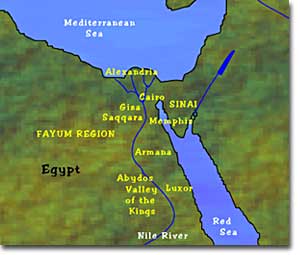
3. Ancient Egypt

The tomb of King Tutankhamun was found almost entirely intact in 1922. This headdress, placed over the mummified head of the deceased king in 1343 B.C.E., is made entirely of gold.
Hieroglyphics, pyramids, mummies, the Sphinx of Giza, King Tut, and Cleopatra.
The sands of the Nile River Valley hold many clues about one of the most mysterious, progressive, and artistic ancient civilizations. A great deal of evidence survives about how the ancient Egyptians lived, but questions remain. Even the wise sphinx would have trouble answering some of them. How were the pyramids built? Who came up with the idea for mummies and why? What was a typical day like for a pharaoh?
In De-Nile

The Nile Valley was the seat of an ancient Egyptian civilization that spanned over 4,000 years.
In 3,000 B.C.E., Egypt looked similar geographically to the way it looks today. The country was mostly covered by desert. But along the Nile River was a fertile swath that proved — and still proves — a life source for many Egyptians.
The Nile is the longest river in the world; it flows northward for nearly 4,200 miles. In ancient times, crops could be grown only along a narrow, 12-mile stretch of land that borders the river. Early Egyptians grew crops such as beans, wheat, and cotton. Despite the lack of many natural resources, such as forests or an abundance of land for farming, a great society emerged.

Egyptians artisans smelted copper and gold for artistic, architectural, and even military purposes.

The Book of the Dead was written using special cursive pictograms that link hieroglyphics to the hieratic form used in later Egyptian religious writings.
Earlier in history, Neolithic (late Stone Age) people thrived in the Nile Valley. The remains that have been uncovered date back to about 6,000 B.C.E. But it wasn't until 3,800 B.C.E. that the valley's inhabitants began to form a cohesive civilization.
The road to civilization required more organization and increased efficiency. Farmers began producing surplus crops that allowed others not only to concentrate on farming but also to pursue other trades, such as mercantilism or skilled craftwork.
Egyptian artisans created copper tools such as chisels and needles — all new inventions — which allowed them to fabricate ornamental jewelry. Artisans also discovered how to make bronze by mixing copper and tin, which marked the beginning of the Bronze Age.
Evidence suggests that ancient Egyptians invented the potter's wheel. This tool made it easier to create pots and jars for storage, cooking, religious needs, and decoration.
Pharaohs and the Legacy of Ancient Egypt
The pharaohs who ruled Egypt for about 3,000 years were by and large capable administrators, strong military leaders, sophisticated traders, and overseers of great building projects.
A Brief Timeline of Ancient Egypt
Foundation to Demise
Ancient Egypt's great civilization spanned thousands of years, from c. 3000 B.C. until the annexation by Rome in 30 B.C.E.
| DATE (B.C.E.) | |
| 6000 | First inhabitants settle along the Nile Delta. |
| 2900 | King Menes unites Upper and Lower Egypt. |
| 2772 | 365-day calendar is invented. |
| 2750 | The Old Kingdom is established with its capital in Memphis. |
| 2560 | King Khufu (Cheops) builds the Great Pyramids of Giza. |
| 2181 | Instability and corruption weaken the empire. |
| 2050 | The Middle Kingdom is established and the capital moves to Thebes. |
| 1750 | The Hyksos, a group of Semitic-Asiatics, invade and rule Egypt. |
| 1550 | The Hyksos are expelled and the New Kingdom established. |
| 1500 | Queen Hatshepsut expands the empire south (Nubia) and east (Palestine). |
| 1380 | Amenhotep IV ("Akhenaton") supports worship of only one god, the sun-disk god Aton. |
| 1336 | Tutankhamun ("King Tut") revives polytheism and returns to the capital to Thebes. |
| 1290 | Ramses II ("The Great") begins a 67-year reign and completes Temple of Luxor. |
| 1283 | Egyptians and Hittites sign the first recorded peace treaty. |
| 712 | Egypt is invaded from the south by the Nubian Empire, which starts an "Ethiopian Dynasty." |
| 670 | Assyrians conquer Egypt. |
| 525 | The Persian Empire conquers Egypt. |
| 343 | Nectanebo II, the last Egyptian-born pharaoh, dies. |
| 332 | Alexander the Great of Macedonia invades Egypt. |
| 331 | The city of Alexandria is established and the Macedonian general Ptolemy begins new dynasty. |
| 51 | The Ptolemaic queen Cleopatra VII rules Egypt, assisted by Julius Caesar. |
| 30 | Cleopatra commits suicide, and Egypt is annexed by the Roman Empire. |
Writing also set the Egyptians apart from some of their neighbors. Egyptians used hieroglyphics or pictures to represent words or sounds. This early form of writing was discovered by the Western world after Napoleon's army invaded Egypt in 1798. The Rosetta Stone, a black tablet containing inscriptions, was deciphered and became crucial in unlocking the mystery of hieroglyphics and understanding Egyptian history.
Ancient Egyptian civilization lasted for several thousand years. Many of its discoveries and practices have survived an even greater test of time.
In fact, one of the ancient Egyptians' inventions, the calendar, has helped define time itself.






